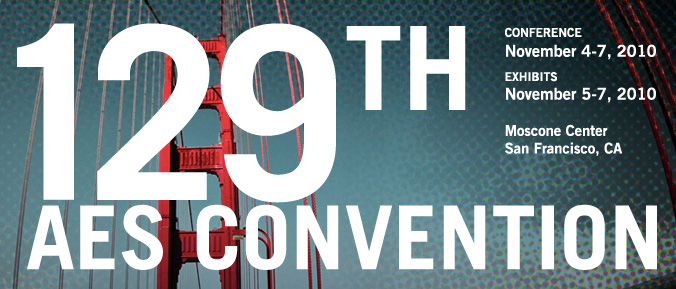
AES San Francisco 2010
Paper Session P9
P9 - Listening Tests
Friday, November 5, 11:00 am — 1:00 pm (Room 220)
Chair:
Jon Boley
P9-1 A Digital-Domain Listening Test for High-Resolution—John Vanderkooy, University of Waterloo - Waterloo, Ontario, Canada
There is much debate over whether sampling rates and wordlengths greater than the CD standard are significant for high-quality audio. Tests that have been done require extreme care in selecting compatible devices with known characteristics. I propose tests that use the highest-quality wide-band microphones, only one set of ADCs and DACs, and wide-band reproducing loudspeakers. Real music and artificial signals can be used that have ultrasonic content. The ADCs and DACs are always used at the same extended bit width and high sampling rate, typically 24 bits and 176.4 or 192 kHz. To perform comparative tests at reduced sampling rates and lower bit widths, the digital data is mathematically altered to conform closely to the reduced specification. Files so created can be played back with precise time registration and identical level. ABX tests can be used to quantify if differences are heard, and ensure blindness of tests. Switching of program material can be done in the digital domain, so that relays or other compromising connectivity can be avoided. This paper discusses some remaining difficult issues and outlines the mathematical computations that will be necessary for sample-rate conversion, linear-phase aliasing and reconstruction filters, dithering, and noise shaping of the processed signal.
Convention Paper 8203 (Purchase now)
P9-2 Variance in Level Preference of Balance Engineers: A Study of Mixing Preference and Variance Over Time—Richard King, Brett Leonard, Grzegorz Sikora, McGill University - Montreal, Quebec, Canada
Limited research has been conducted that quantifies how much expert listeners vary over time. A task-based testing method is employed to discern the range of variance an expert listener displays over both short and long periods of time. Mixing engineers are presented with a basic mixing task comprised of one stereo backing track and a solo instrument or voice. By tracking the range in level in which the mixing engineers place a soloist into an accompanying track over a number of trials, trends are observed. Distributions are calculated for three genres of music and variance is calculated over time. The results show that in fact the variance is relatively low, and even lower for the more experienced subjects. These results also provide a baseline for future testing.
Convention Paper 8204 (Purchase now)
P9-3 Evaluation of Superwideband Speech and Audio Codecs—Ulf Wüstenhagen, Bernhard Feiten, Jens Kroll, Alexander Raake, Marcel Wältermann, Deutsche Telekom AG Laboratories - Berlin, Germany
Increasingly growing usage of headphones for different telephony applications is paired with an increased quality expectation of the user. Recently, different standardization bodies have started work on an enhancement of telephone services. One objective is to improve the quality by providing a codec that supports low-delay super-wideband or fullband quality and in addition show a good quality not only for speech but also for music. Deutsche Telekom Laboratories have evaluated a range of low-delay super-wideband speech and audio codecs in comprehensive listening tests. The tests were conducted using the MUSHRA test method. A mixture of speech and audio conditions were used to check the performance of the codecs for different program types. The results of the listening tests are presented and discussed in the light of future applications.
Convention Paper 8205 (Purchase now)
P9-4 Subjective Listening Tests and Neural Correlates of Speech Degradation in Case of Signal-Correlated Noise—Jan-Niklas Antons, Anne K. Porbadnigk, Robert Schleicher, Benjamin Blankertz, Sebastian Möller, Berlin Institute of Technology - Berlin, Germany; Gabriel Curio, Charité-University Medicine - Berlin, Germany
In this paper we examine whether particularly sensitivity of the human cortex to reduction in speech quality is visible in the electroencephalogram (EEG) and whether these measures can be used to improve the behavioral assessment of speech quality. We degraded a speech stimulus (vowel /a/) in a scalable way and asked for a behavioral rating. In addition, the brain activity was measured with EEG. We trained classifiers, who were found capable of distinguishing between events that are seemingly similar at the behavioral level (i.e., no button press), neurally, however, noise contamination is detected, possibly affecting the long-term contentment with the transmission quality.
Convention Paper 8206 (Purchase now)
